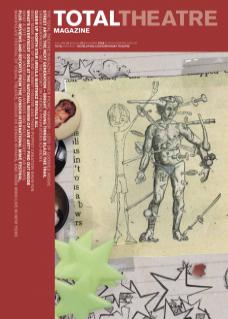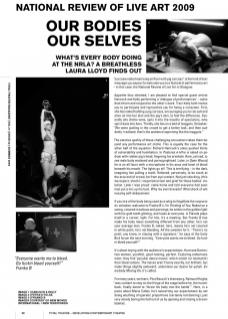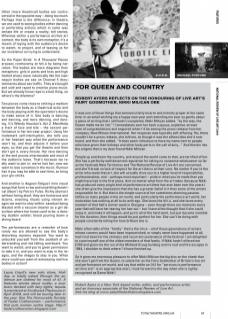‘Just saw naked man lying on floor with pig carcass’ is the kind of text message you expect to welcome you to a festival of performance art – in this case, the National Review of Live Art in Glasgow.
Appetite thus whetted, I am pleased to find special guest artists Hancock and Kelly performing a ‘dialogue of performances’ – solos that inform and respond to the other’s work. Traci Kelly both invites you to participate and reproaches you for being a consumer. First, she lies naked holding a pig carcass, encouraging you to rub salt and olive oil into her skin and the pig’s skin, to feel the difference. Secondly she drinks wine, spits it into the mouths of spectators, who spit it back into hers. Thirdly, she lies on a bed of maggots. Onlooker: ‘We were jostling in the crowd to get a better look, and then suddenly I realised, that’s the audience squirming like the maggots.’
The emotive quality of these challenging encounters takes them beyond any performance art cliché. This is equally the case for the other half of the equation: Richard Hancock’s solos pushed limits of vulnerability and humiliation. In Postures A-M he is naked on podium with rubber pig’s head, fingering his arsehole. Rare, yet sad, to see the male body enslaved and pornographised. Later, in Open Wound, he is on all fours with a microphone in his anus and bowl of blood beneath his mouth. The lights go off. This is terrifying – in the dark, imagining him pulling a tooth. Relieved, perversely, to be stuck at the arse end of crowd, far from eye contact. Not just shocking (this we expect, shock); I experience fear and grief for these bodies’ violation. Later I was proud: came home and told everyone had seen man put a mic up his bum. Why my own bravado? Aftershock of witnessing self-debasement.
If you tire of the body being used as a whip to flagellate the voyeuristic onlooker, welcome to Franko B’s I’m Thinking of You. Naked on a swing, covered in tattoos and piercings, he smiles in the golden light with his gold teeth glinting, and looks at everyone. A Pianola plays itself in a corner; light. For him, it’s a meeting. But Franko B has made his body mean something different from any other; he’s not your average man. Franko B, naked, here, means he’s not covered in white paint, he’s not bleeding. All the sweeter for it. ‘There’s no point, you know, in staying with a signature,’ he says at the Early Bird forum the next morning. ‘Everyone wants me to bleed. Go fuckin bleed yourself!’
It’s about toying with the audience’s expectations. Hunt and Darton: two women, youthful, good-looking, perfect. Exploring embarrassment, they find ‘peculiar dance moves’ which match (or mismatch) their observations. The moves aren’t funny exactly, nor brilliant, but make things slightly awkward; undermine our desire for polish. Everybody Moving On, it’s called.
For many years, we learn, Pina Bausch’s dramaturg, Raimund Hoghe, ‘was content to stay on the fringe of the stage before he, the hunchback, finally dared to “throw his body into the battle”’. Here, in a piece about Maria Callas, he’s subverting our expectations by not doing anything of operatic proportions (certainly not dancing), just very slowly boring the hell out of us by opening and closing a brown blanket.
“Everyone wants me to bleed. Go fuckin bleed yourself!”
Other (more theatrical) bodies are controversial in the opposite way – doing too much. Perhaps that is the difference: in theatre, we are used to seeing bodies either dancing or performing actions which in some way imitate life or create a reality, tell stories. Whereas within a performance art / live art context, the body is its own metaphor, it’s a means of toying with the audience’s desire to watch, to project, and of teasing us for our insistence on trying to understand.
So the Paper Birds’ In A Thousand Pieces arouses controversy at NRLA by being narrative. The bodies are more diagrams than metaphors: girls in pants and bras and high heeled shoes move robotically like the mannequin bodies we see on Channel 5 documentaries about sex traffic. They are bought and sold and raped to emotive piano music. But we already know rape is a bad thing, so where’s the dilemma?
Two pieces come close to striking a medium between the body as a theatrical actor and the body playing with the spectator’s desire to make sense of it. One body is dancing, and dancing, and more dancing, and dancing. It’s Wendy Houstoun’s Act 2, Manifesto, a tract of love and bile – the second performance in her ten-year project. Using her trademark self-interruption, she tells you in her hesitant way what the performance won’t be, and then adjusts it before your eyes, so that you get the theatre and then don’t get it, every minute. Her rave dancing at the end proves interminable and most of the audience leave. That’s because we really want to join in: we’ve lost her, now we want to lose ourselves in the music. Rumour has it you may be able to next time, so bring your glo-sticks.
And another is Aegean Fatigue (‘nine visual songs that form a raw and unsettling theatrical album’) by Petra’s Pulse. Richly abstract without being aloof, they are humorous and bizarre, enacting rituals using vibrant images we want to stay within: sawdust being blasted with a vacuum cleaner as a girl describes where her home used to be; a dancing dustbin soldier; blood pouring down a diving board.
The performances are a reminder of how rarely we are allowed to see the body’s disturbing mystery exposed. You want to unbuckle yourself from the seatbelt of understanding and risk falling overboard. You want to watch, and you’re given permission to take it in, and you want to stay in the images, and the images to stay in you. What more could you want of witnessing real live bodies in action?
Laura Lloyd’s new solo show, Holiday, is totally naked (though the audience are clothed for most of it). It features stories about nudity; a sombrero decked with fairy lights; tequila. It premiered at Southwark Playhouse in April 2009, and will be touring later in the year. See The Honourable Society of Faster Craftswomen – performance that puts women centre stage. http://fastercraftswomen.blogspot.com


